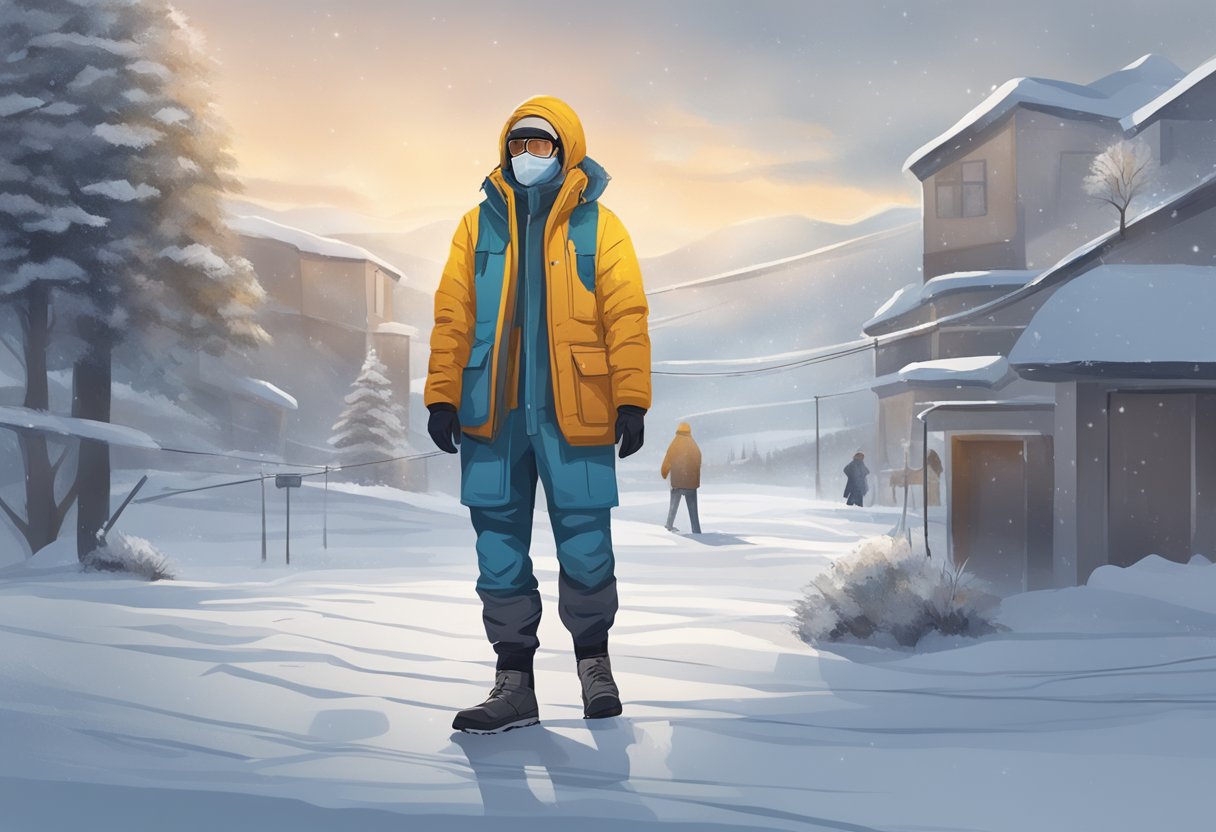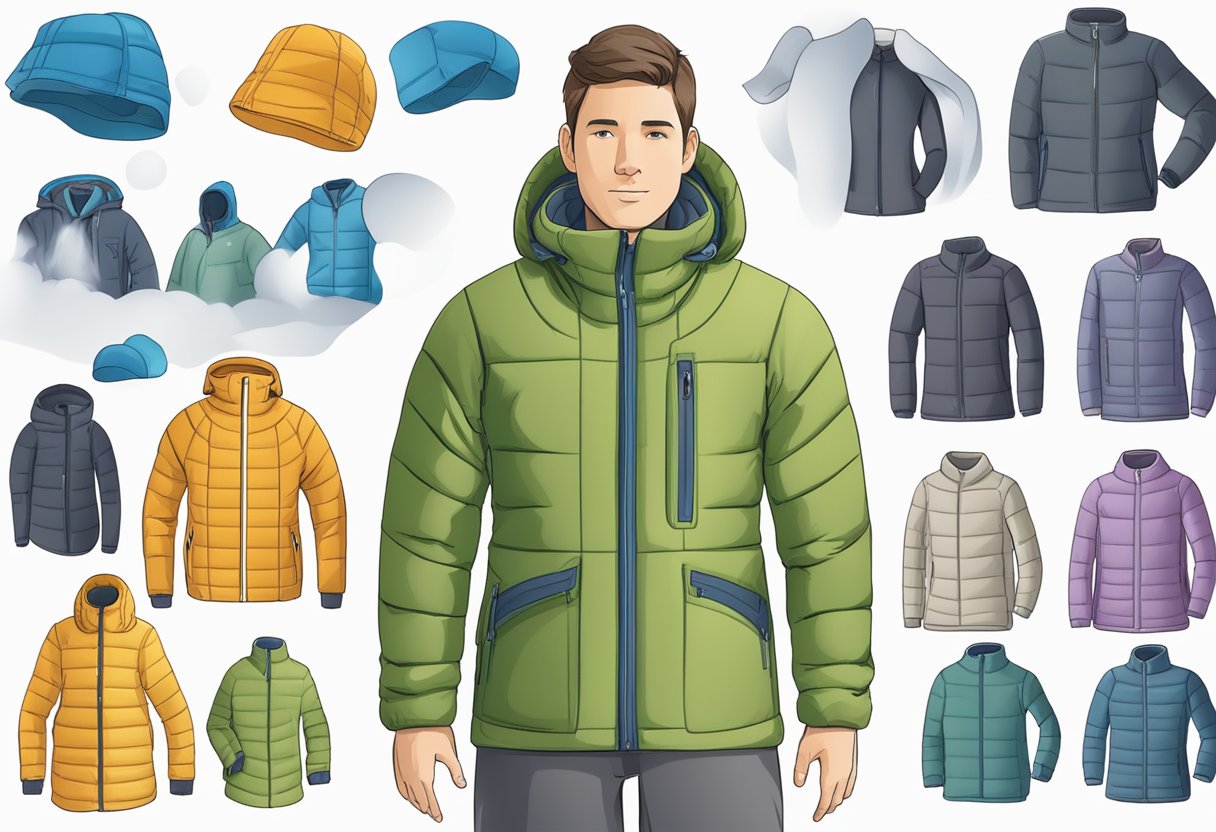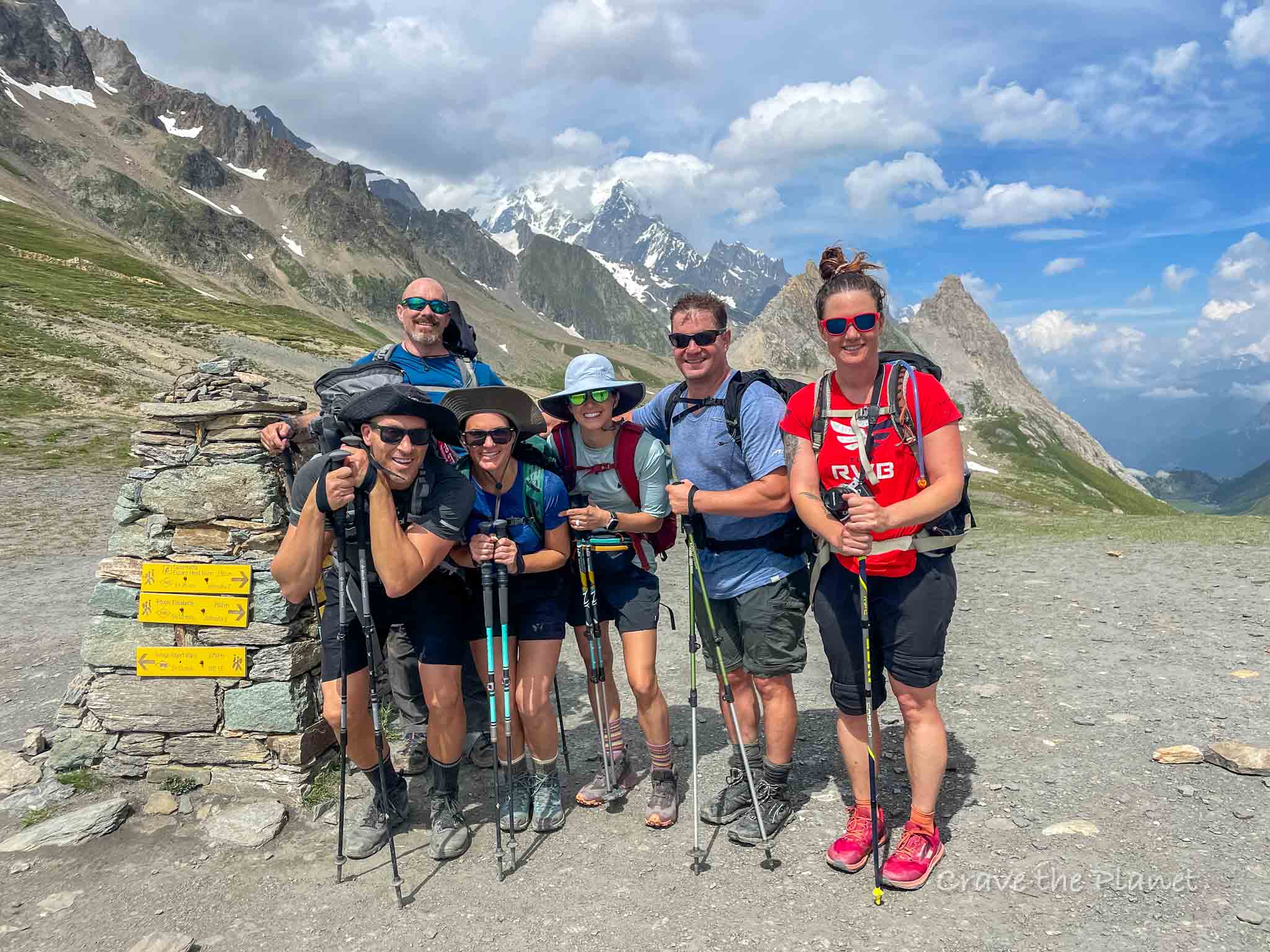Yes, you should be concerned about layering for winter hiking.
Let me share with you my insight on cold weather layering tips based on my varied success hiking in the winter.
Sometimes I have not been the most prepared. Don’t be like me. Trust me, you’ll want to be prepped for the weather to enjoy your hike more. That’s why I’ve done the research and am sharing it with you now.
3 Cold Weather Layering Tips

When you venture into cold conditions, knowing how to effectively layer your clothing is crucial to regulate your body temperature and stay dry.
This involves understanding the materials and construction that provide insulation, protection and moisture wicking.
The Science of Layering: Cold Weather Layering Tips
Layering clothing for cold weather is based on the principle that trapped air between layers provides insulation.
This is because air is a poor conductor of heat, which means it can effectively trap warmth close to your body.
The strategy entails wearing multiple pieces of clothing that work together to keep you warm, dry, and protected from the elements and frostbite.
👉 Each layer has a purpose: the base layer manages moisture, the middle layer insulates, and the outer layer shields you from wind and precipitation.
Key Principles of Layering:
- Insulation: Trapped air warms up and acts as a barrier against the cold.
- Moisture Management: Excess sweat can lead to rapid heat loss; moisture-wicking fabrics are essential.
- Protection: From wind and moisture and cold.
1. Choosing the Right Base Layer
Layering Basics 101
Your base layer is in direct contact with your skin and, therefore, plays a critical role in regulating body temperature and comfort.
For cold weather, materials such as merino wool, polyester, and silk are preferred for their moisture-wicking properties.
Merino wool stands out with its ability to provide warmth while remaining breathable.
Polyester is a synthetic alternative that is also effective at wicking moisture away from your skin.
Silk is a lightweight option that offers a luxurious feel with good wicking and insulating properties.
Properties of Common Base Layer Materials:
| Material | Breathable | Wicking Ability | Warmth | Durability |
|---|---|---|---|---|
| Merino Wool | High | High | High | Moderate |
| Polyester | Moderate | High | Moderate | High |
| Silk | Moderate | Moderate | Moderate | Moderate |
It’s important to select a base layer that meets your specific needs; for intense activities, a highly breathable and moisture-wicking base layer will help keep your skin dry and prevent rapid temperature changes.
For more static activities, warmth and insulation might take a precedence.
2. Mid-Layer Mastery
The mid-layer is your main defense against the cold, acting as the insulating layer that traps body heat and maintains warmth.
Importance of Insulation
Insulation in your mid-layer is vital to keep your body at an optimal temperature in cold conditions. Without proper insulation, you risk losing heat rapidly, leading to discomfort and potentially dangerous situations.
When selecting a mid-layer, consider both the insulation type and the weight based on your activity level.
Key Facts: Insulation
| Insulation Type | Warmth Potential | Weight | Best Use |
|---|---|---|---|
| Fleece | High | Light to Medium | High-exertion activities |
| Down | Very High | Light | Inactive periods or very cold conditions |
| Synthetic | Moderate to High | Varies | Wet conditions |
Selecting Mid-Layer Materials
Your mid-layer options largely fall between natural fibers like wool and synthetic insulation materials, including polyesters. When choosing a mid-layer, consider the materials carefully:
- Fleece is a common synthetic option that offers excellent warmth while remaining breathable for active use.
- Down provides exceptional warmth and compressibility, perfect for colder, drier environments or when less movement is expected.
- Wool, particularly merino, is a natural midweight option offering a balance between warmth and moisture management.
- Synthetic insulation often incorporates various polyesters, which are quick-drying and provide insulation even when wet.
Materials Comparison:
| Material | Warmth | Breathability | Moisture Resistance | Durability |
|---|---|---|---|---|
| Fleece | Mid | High | Low | High |
| Down | High | Low | Low-Moderate | Moderate |
| Wool | Mid-High | High | High | High |
| Synthetic Insulation | Mid-High | Moderate | High | Moderate-High |
3. Outer Layer Considerations

When preparing for cold weather, your outer layer is your first line of defense against the elements. This layer should provide protection while maintaining comfort and mobility.
Protecting Against the Elements
Your outer layer, often a shell jacket, serves to shield you from wind, rain, and snow. It is crucial to select a jacket that is windproof and waterproof to fend off harsh conditions. Brands like Canada Goose have built a reputation for high-quality outerwear that withstands severe weather. For less extreme conditions, a water-resistant jacket may suffice, offering breathability while still offering some protection against moisture.
Material Considerations:
| Feature | Benefit |
|---|---|
| Windproof | Blocks windchill, preserving body heat |
| Waterproof | Prevents rain and snow from soaking through |
| Water-Resistant | Repels light rain, maintains breathability |
Material and Functionality of Outer Shells
The functionality of outer shells hinges on their materials. Gore-Tex, for instance, is renowned for its ability to repel water while allowing vapor to escape, a property that you should look for in your outerwear. It’s essential your jacket has a balance of protection and breathability to manage various activity levels.
Shell Jacket Features:
| Material | Functionality |
|---|---|
| Gore-Tex | Waterproof, windproof, and breathable |
| Goretex | Same as above, alternative branding |
| Generic | May offer less protection but at a more accessible price point |
Remember, the perfect shell jacket for someone else may not be the best for you. Consider your specific needs, such as climate and activity level, when choosing your outerwear.
Accessorizing for Cold Weather

When bracing for the cold, selecting the right accessories is crucial to ensure your comfort. These items work in tandem with your base and insulation layers to protect against the chill.
Head to Toe: Completing Your Layered Look
Headwear: A warm hat is essential, as a significant amount of body heat can be lost through the head. Choose hats that cover your ears and are made of materials like wool or fleece for optimal warmth.
Neckwear: Scarves or neck gaiters provide necessary insulation for your neck. Wrapping up with a scarf also allows you to cover your face in blustery conditions.
| Accessory | Material | Function |
|---|---|---|
| Hats | Wool, Fleece | Retains heat, covers ears |
| Scarves | Wool, Synthetic | Insulates neck, can cover face |
Handwear: Gloves should offer dexterity and warmth. For extreme cold, mittens are warmer than gloves, as they keep fingers together to share warmth.
Footwear: Waterproof boots are essential to keeping feet dry. Insulated options add warmth, and socks should be a blend of wool and synthetic fibers for moisture-wicking and heat retention.
| Item | Attributes | Importance |
|---|---|---|
| Gloves | Dexterity, Insulation | Essential for hand warmth |
| Mittens | Maximum Warmth | Best for extreme cold |
| Waterproof Boots | Waterproof, Insulated | Key for dry, warm feet |
| Heated Socks | Wool-Synthetic Blend | Moisture-wicking, Warm, Battery Powered |
Additional Footwear: Gaiters can be worn over boots to add a layer of protection against snow and moisture seeping into your boots.
Specialty Items for Extreme Conditions
A well-insulated parka or puffy jacket serves as an integral outer layer, locking in warmth. For additional core warmth, consider a vest which can be worn under the parka for an added heat-trapping layer without restricting arm movement.
In harsh, wet conditions, waterproof accessories are non-negotiable. Waterproof gloves or mittens keep your hands dry and functional.
Insulated Accessories:
- Vests: Provide core warmth without bulk
- Gaiters: Protect lower legs and prevent snow from entering boots
When navigating through cold extremes, your fashion choices should be influenced by functionality to maintain body heat and comfort. Layering with the right accessories is not just about style; it’s a strategic approach to cold-weather dressing.
Fitting and Sizing Layers
When preparing for cold weather, selecting properly fitted layers is paramount to maintain warmth without sacrificing comfort.
Ensuring Effective Layering
The foundation of effective layering hinges on the fit. Each layer should accommodate the one beneath without restricting movement or cutting off circulation. Men, women, and children have different fitting needs, and it’s essential that the clothing caters to these differences to keep body heat trapped effectively.
Base Layer: Provides moisture management.
- Men: Should be snug but not tight
- Women: Form-fitting with flexibility
- Children: Close-fitting yet allows for growth
Mid Layer: Insulates and retains heat.
- Men: Slightly looser for a comfortable range of motion
- Women: Tailored to preserve warmth without the bulk
- Children: Adjustable as needed for rapid growth spurts
Outer Layer: Protects from wind and precipitation.
- Men: Room for underlying layers, adjustable cuffs and hems
- Women: Slimmer profiles with articulated joints
- Children: Durable and roomy to accommodate active play
Adjusting Layers for Movement and Comfort
To ensure comfort during activities, adjusting layers for correct thickness and ease of movement is crucial. Your layers should not inhibit motion but should adapt to your activity level.
Activity Consideration:
- Low Activity: Increase layer thickness to retain more heat.
- High Activity: Wear breathable, thinner layers to avoid overheating.
Comfort Adjustment Tips:
- Zippers: Look for pit zips or venting options on mid and outer layers.
- Elastics and Adjusters: Use waistbands, cuffs, and hems with adjustable features to secure heat or release excess warmth.
- Collection Management: Rotate and maintain a collection of layers to suit different conditions and activities.
Layering for Specific Activities
Proper layering is essential for staying warm and dry during cold weather activities. Whether you’re engaging in winter sports or simply going about your daily routine, the right layering system can make all the difference. Moisture management and insulation are key components of a successful layering strategy.
Winter Sports and Active Pursuits
When participating in winter sports like skiing or hiking, you need layers that wick away moisture and insulate against the cold while allowing for flexibility and breathability.
- Base Layer: Opt for synthetic fabrics or merino wool that wick sweat away from your body to keep you dry.
- Mid Layer: Add insulation with a fleece or down jacket that traps heat but is also breathable.
- Outer Layer: Your shell should protect against wind and water without sacrificing ventilation.
Hiking and Camping:
- Head and Hands: Use insulated gloves and a warm hat to prevent heat loss.
- Feet: Wool or synthetic socks are critical to keeping feet warm and dry.
Layering Example Table:
| Activity | Base Layer | Mid Layer | Outer Layer | Accessories |
|---|---|---|---|---|
| Hiking | Moisture-wicking fabric | Fleece jacket | Waterproof breathable shell | Insulated gloves, wool hat |
| Skiing | Synthetic or wool | Down or synthetic loft | Weatherproof technical shell | Snow goggles, neck gaiter |
Casual Wear and Everyday Comfort
For casual winter wear and daily activities, prioritize comfort and versatility in your layers to adapt easily to varying conditions.
- Base Layer: Choose materials that feel good against your skin and can move moisture away.
- Mid Layer: Depending on the temperature, opt for a lighter fleece or sweater that offers warmth without bulk.
- Outer Layer: A down vest or a parka can serve as your casual outerwear, ensuring warmth and style.
When indoors or in milder conditions, consider removing a layer to regulate your body temperature.
Daily Layering Table:
| Occasion | Base Layer | Mid Layer | Outer Layer | Additional Notes |
|---|---|---|---|---|
| Running errands | Long-sleeved top | Wool sweater | Lightweight insulated jacket | Remove layers as needed for comfort |
| Commuting | Thermal wear | Cardigan or pullover | Stylish coat or heavy jacket | Select layers that are easy to take off or put on |
Remember, each cold weather layering tips are unique to each person. But each layer should add to your comfort and protection against the cold, so adjust them based on your activity level and weather conditions for effective moisture management and warmth.
Footwear and Lower Body Layering
When preparing for cold environments, your choice in both footwear and lower body garments is crucial for comfort and protection. Proper layering can keep your feet dry and preserve your body heat effectively.
Boots and Shoes for Cold Climates
Selecting the right boots for cold weather is vital to ensure your feet stay warm and dry. For extremely chilly temperatures, insulated waterproof boots serve as an essential barrier against the elements. They should feature a thick, non-conductive sole to prevent heat loss to the ground. Here, materials matter—nylon and other synthetics typically offer better protection and durability than cotton.
Table 1: Footwear Features
| Feature | Materials | Benefits |
|---|---|---|
| Insulation | Thinsulate, Wool | Traps heat, provides warmth |
| Waterproof | GORE-TEX, Rubber | Keeps feet dry, prevents moisture ingress |
| Sole | Rubber, EVA Foam | Offers insulation, traction, and comfort |
Consider this: Layer your feet as you do your body. Start with moisture-wicking socks to keep your feet dry and follow with a pair of wool socks for warmth. For additional protection, especially when traversing through snow, consider adding gaiters to prevent snow from entering your boots.
Choosing the Right Bottoms
Your legs are just as susceptible to the cold, so dressing them appropriately is key. Begin with moisture-wicking long underwear as a base layer to keep your skin free from perspiration. The mid layer should provide insulation; fleece pants are a good choice because they offer warmth without significant bulk.
Table 2: Layering Bottoms
| Layer | Material | Purpose |
|---|---|---|
| Base Layer | Polyester, Synthetic Blends | Wicks moisture away from the skin |
| Mid Layer | Fleece, Down | Insulates and retains body heat |
| Outer Layer | Nylon, Softshell | Protects against wind and precipitation |
To stay dry, top these layers with a durable, weatherproof outer layer, such as nylon shell pants which can be easily put on or taken off as needed. Fabrics that breathe will prevent moisture buildup from perspiration, which can lead to dampness and chills.
Maintaining Temperature and Comfort
The essence of staying safe and comfortable in cold weather relies on the effective regulation of your body heat and maintaining good blood circulation, particularly to the extremities.
Regulating Core Heat
Your core temperature is crucial for survival; it’s what your body strives to keep constant. Begin with moisture-wicking base layers that pull sweat away from your skin. Then, add insulating layers to trap heat. To manage the balance between insulation and breathability, opt for adjustable and ventilated outer layers. Synthetic fabrics offer resilience and moisture management, crucial for sustained warmth.
Key Points for Core Temperature Regulation:
| Layer | Function | Material Advantages |
|---|---|---|
| Base Layer | Sweat management, warmth | Moisture-wicking properties |
| Mid Layer | Heat retention, added warmth | Flexible, synthetic fabrics |
| Outer Layer | Wind/Water resistance, venting | Breathable, adjustable |
Circulation and Preventing Cold Injuries
Optimal circulation ensures that warm blood reaches your extremities, preventing conditions like frostbite and hypothermia. Avoid tight clothing that can restrict blood flow. Focus on keeping your hands and feet warm with well-fitted gloves and socks, without cutting off circulation.
Preventing Cold Injuries:
- Hands: Use gloves that offer mobility, with synthetic insulation to preserve warmth even when damp.
- Feet: Choose socks with a snug fit, not tight, encouraging circulation; look for insulated yet breathable footwear.
Remember, the goal is to maintain a warm, dry, and comfortable state, reducing the risk of cold-weather injuries while sustaining overall body heat.
Material Advancements and Innovations

As you dress for cold weather, the choice of materials in your layers can drastically affect comfort and performance. Recent innovations have significantly improved the fabrics used in winter layering.
Synthetics vs. Natural Fibers
Synthetics such as polyester and nylon are praised for their functional roles in cold-weather gear. A core advantage of synthetic fibers is their capacity to wick moisture away from your body, which is crucial in maintaining warmth in chilly environments. On the other hand, natural fibers like merino wool offer exceptional breathability and temperature regulation, enhancing comfort through a wide range of conditions.
Here’s a quick comparison to illustrate their unique attributes:
| Property | Synthetic Fibers | Natural Fibers (Merino Wool) |
|---|---|---|
| Moisture-wicking | Excellent | Good |
| Warmth when wet | Maintains some insulation | Maintains significant insulation |
| Durability | High | Moderate |
| Odor resistance | Varies with treatment | Natural odor resistance |
| Care | Generally easier | Requires more special care |
New Technologies in Layering
In recent years, new technologies have emerged, pushing the boundaries of what winter layering can achieve. Synthetic insulation, for example, mimics the loft and compressibility of down while retaining warmth even when wet. Innovations like body-mapped insulation and hybrid designs, which employ both synthetic and natural materials in strategic zones, enhance your overall thermal efficiency.
- Body-mapped Insulation: Delivers warmth where it’s needed most while reducing bulk.
- Hybrid Designs: Combine synthetic and natural layers for optimized performance.
These advancements refine your layering strategy, aligning it closer to your body’s unique thermo-regulatory needs during cold exposure.
Building a Versatile Winter Wardrobe
To effectively navigate the cold season, you must consider both functionality and fashion when selecting winter layers. Your wardrobe should accommodate fluctuating temperatures and be versatile enough to extend beyond the coldest months.
Layering for Different Weather Conditions
When building your winter wardrobe, start with a base layer that manages moisture; merino wool is highly recommended for its warmth and breathability. It’s imperative to have a selection of mid-layers like fleece or down jackets that offer insulation. Your outer layer should protect against wind and precipitation, so look for waterproof and windproof materials. Here’s a simple table outlining the core layers:
| Layer | Function | Clothing Examples |
|---|---|---|
| Base Layer | Moisture Management | Merino Wool Long Johns |
| Mid-Layer | Insulation | Fleece Sweaters, Down Vests |
| Outer Layer | Weather Protection | Waterproof/Breathable Shell Jackets |
In terms of sweaters, aim for a variety that includes lightweight knits for moderately cold days and heavier weaves for the bitter cold. For shopping, both men and women should consider the fit and versatility of each piece and how it can be combined with other pieces for maximum usage.
Extending Your Layering Beyond the Cold
Your winter wardrobe can be more than just about combating the cold. By selecting timeless pieces such as wool sweaters and durable outerwear, you can transition into spring with ease. Children’s clothing should be both functional and allow for layers to be removed as they are often more active and thus can overheat more easily. Here’s how you can extend the use of your winter wardrobe:
- Sweaters: Pair them with lighter garments during transitional weather.
- Outer Layer: Use rain shells over a single layer on rainy, yet milder days.
Building a collection that serves multiple purposes will not only provide warmth during winter but also offer adaptable fashion choices throughout the year. Remember, the key to a functional and stylish winter wardrobe lies in the quality and versatility of your layering pieces.
Craving Adventure?
Hut to hut hiking in Europe does not include more than 3 layers. ⭐️
⭐️⭐️⭐️Best Guided Tour for Beginners - 4 Days Tour du Mont Blanc Hike
Based on my personal experience, Skyhook Adventures offers the best 4 day TMB hiking experience that's do-able for most people.
Perfect option for busy people that just want to show up, feel safe with a guide and hike without doing any logistics.
The tour features small groups (<10 typically) and
- all transfers/breakfast/dinner/accommodations included
- airport transfer included
- stay in the insanely beautiful Rifugio Bonatti and other huts at high elevation
Note: Skyhook hires only local Chamonix guides.
Frequently Asked Questions

Effective cold-weather layering ensures your comfort and safety in harsh conditions. Understanding the types of layers and materials can help you stay warm without hindering movement.
What are the essential types of layers needed for cold climates?
You’ll need three main types of layers for cold climates: a moisture-wicking base layer, an insulating middle layer, and a protective outer layer. The base layer keeps your skin dry, the middle layer traps heat to keep you warm, and the outer layer shields you from wind and precipitation.
How can one effectively layer clothing to maximize warmth without adding bulk?
To maximize warmth without bulk, start with a snug-fitting base layer. Add a light, insulating fleece or down jacket as your middle layer. Opt for a fitted, breathable outer shell. Thinner, more technical fabrics often provide comparable insulation to thicker materials without the added weight.
What is the ideal material for a base layer when dressing for low temperatures?
The ideal base layer material should be synthetic or merino wool, as they excel at moisture management, keeping your skin dry and maintaining warmth when wet.
| Material | Moisture Wicking | Warmth when wet |
|---|---|---|
| Synthetic | Excellent | Good |
| Merino Wool | Very Good | Excellent |
What considerations should be made when choosing layers for wet and cold conditions?
When choosing layers for wet and cold conditions, focus on waterproof and breathable materials for your outer layer. Also, make sure your insulating layers retain heat when damp and avoid cotton as it loses insulation power when wet.
How should one modify their layering technique for outdoor activities in extreme cold?
In extreme cold, add an additional mid-layer to increase insulation, such as a down-filled vest or jacket. Ensure your outer layer is resilient to lower temperatures and windproof, and consider layering a balaclava or face mask for added protection.
What are the most effective strategies for layering clothing during winter travel?
For winter travel, dress in versatile layers that can be easily added or removed. Pack lightweight, compressible items, and always have a waterproof outer layer handy. Also, keep essential accessories like gloves, a warm hat, and thermal socks within reach.
| Strategy | Description |
|---|---|
| Versatile Layers | Items that can be easily put on or taken off depending on the temperature. |
| Lightweight Items | Garments that provide warmth without taking up too much space in your luggage. |
| Waterproof Outer Layer | A shell layer that will keep you dry and can be worn over other layers. |
| Essential Accessories | Gloves, hat, and socks to protect extremities. |
Planning your trip?
- 🏨 Book your perfect stay on Booking.com
- 🎢 Make your trip more exciting with GetYourGuide
- 🚗 Hire a car with Discover Cars
- ✈️ Find cheap flight tickets with WayAway
- 📲 Buy eSIMs with Airalo
- 🥾 Get off the beaten tourist path with Fully Planned and Booked Self-Guided Hut to Hut Hiking Trip
- 🥾⭐️ Step into social adventure with Guided Group Adventure and Hiking Tours in Europe with Local Guides.
More Cold Weather Outdoor Buying Guides
We hope this guide filled with interesting information about cold weather layering tips has given you the proper information to plan your next adventure.

Author profile: Morgan Fielder is a Doctor of Physical Therapy and passionate hiker who believes in exploring the world on foot with good food. Follow her journey as she shares science-based hiking tips and advocates for sustainable tourism.

